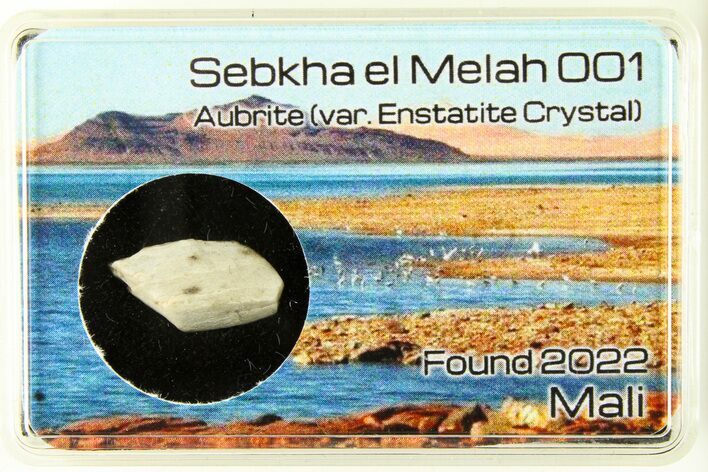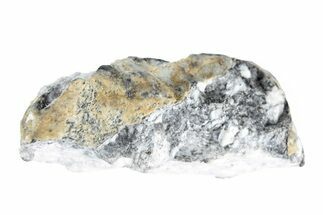This Specimen has been sold.
.56" Aubrite Meteorite Fragment - Sebkha el Melah 001
This is a beautiful .56" wide enstatite crystal from the meteorite known as Sebkha el Melah 001, an unusual kind of achondrite called an aubrite. They are meteorites made of entstatite in igneous and impact-melted clasts that likely come from E-type asteroids. This meteorite is particularly unusual for its large enstatite crystals and pegmatitic structure.
It comes in an acrylic display case.
It comes in an acrylic display case.
This meteorite is a rare aubrite achondrite found in Mali in 2022. It was found in the region known as Wad Alhath, about 245 kilometers southeast of Taoudenni, a salt-mining region in northern Mali. To date, about 17 kilograms have been recovered.
Aubrites are already unusual, but Sebkha el Melah is even more so: it is mainly comprised of large enstatite crystals interlocked in pegmatitic structures--almost 98 percent of it is enstatite alone. Many of these crystals measure several centimeters long! These gorgeous crystals are known to pop free from their main masses. White to cream-colored fusion crust covers parts of the meteorite, and it shows no signs of brecciation. This is an incredibly rare and gorgeous look into this mysterious class of meteorites, and a worthy addition to any collection.
Aubrites are already unusual, but Sebkha el Melah is even more so: it is mainly comprised of large enstatite crystals interlocked in pegmatitic structures--almost 98 percent of it is enstatite alone. Many of these crystals measure several centimeters long! These gorgeous crystals are known to pop free from their main masses. White to cream-colored fusion crust covers parts of the meteorite, and it shows no signs of brecciation. This is an incredibly rare and gorgeous look into this mysterious class of meteorites, and a worthy addition to any collection.
About Aubrites
Aubrites are a unique class of achondritic meteorites that represent some quite extreme formation conditions in the early solar system. Aubrites are almost all breccias consisting of whitish enstatite, with occasional inclusions of olivines, nickel-iron, and troilite, along with impact-melted clasts seen in achondrites.
Enstatite is a form of orthopyroxene that forms in igneous conditions and is considered an early stage of mineral formation in the solar system. Enstatite meteorites likely originate from E-type (enstatite-rich) asteroids close to the sun, particularly the near-Earth object 3130-Eger. It has even been observed outside of the solar system around evolved stars and planetary nebulae!
Aubrites are a unique class of achondritic meteorites that represent some quite extreme formation conditions in the early solar system. Aubrites are almost all breccias consisting of whitish enstatite, with occasional inclusions of olivines, nickel-iron, and troilite, along with impact-melted clasts seen in achondrites.
Enstatite is a form of orthopyroxene that forms in igneous conditions and is considered an early stage of mineral formation in the solar system. Enstatite meteorites likely originate from E-type (enstatite-rich) asteroids close to the sun, particularly the near-Earth object 3130-Eger. It has even been observed outside of the solar system around evolved stars and planetary nebulae!
About Achondrites
Achondrites are a type of stony meteorite that lacks chondrules--round grains that aggregate from molten or partially molten droplets in space to form chondrites. Achondrites still contain grains, but their textures are extremely distinct and analogous with igneous processes rather than the chondrule-producing conditions at the beginning of the solar system.
Achondrites make up about 8 percent of all known meteorites. They are almost all regolith breccias, ejected from impacts on larger asteroids and sometimes the moon and Mars. Most are HED (howardite-eucrite-diogenite) in composition, sourced from the asteroid Vesta: it is the second largest asteroid in the Solar System and the only asteroid visible to the naked eye.
Achondrites are a type of stony meteorite that lacks chondrules--round grains that aggregate from molten or partially molten droplets in space to form chondrites. Achondrites still contain grains, but their textures are extremely distinct and analogous with igneous processes rather than the chondrule-producing conditions at the beginning of the solar system.
Achondrites make up about 8 percent of all known meteorites. They are almost all regolith breccias, ejected from impacts on larger asteroids and sometimes the moon and Mars. Most are HED (howardite-eucrite-diogenite) in composition, sourced from the asteroid Vesta: it is the second largest asteroid in the Solar System and the only asteroid visible to the naked eye.
TYPE
Enstatite Achondrite (Aubrite)
AGE
LOCATION
Sebkha el Melah, Wad Alhath, Northern Mali
SIZE
.56" wide
CATEGORY
SUB CATEGORY
ITEM
#285358
 Reviews
Reviews












